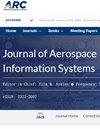Loss-of-Control Prediction of a Quadcopter Using Recurrent Neural Networks
IF 1.5
4区 工程技术
Q2 ENGINEERING, AEROSPACE
引用次数: 0
Abstract
Loss of control (LOC) is a prevalent cause of drone crashes. Onboard prevention systems should be designed requiring low computing power, for which data-driven techniques provide a promising solution. This study proposes the use of recurrent neural networks (RNNs) for LOC prediction. Four architectures were trained in order to identify which RNN configuration is most suitable and if this model can predict LOC for changing aerodynamic characteristics, wind conditions, quadcopter types, and LOC events. One-hundred and seventy-two real-world LOC events were conducted using a 53 g Tiny Whoop, a 73 g URUAV UZ85, and a 265 g GEPRC CineGO quadcopter. For these flights, LOC was initiated by demanding an excessive yaw rate (2000 deg/s), which provokes an unrecoverable upset and subsequent crash. All RNNs were trained using only onboard sensor measurements. It was found that the commanded rotor values provided the clearest early warning signals for LOC because these values showed saturation before LOC. Moreover, all four architectures could correctly and reliably predict the impending LOC event 2 s before it actually occurred. Furthermore, to investigate generality of the methodology, the predictors were successfully applied to flight data in which the quadcopter mass, blade diameter, and blade count were varied.基于递归神经网络的四轴飞行器失控预测
失去控制(LOC)是无人机坠毁的普遍原因。机载预防系统的设计需要低计算能力,为此数据驱动技术提供了一个有前途的解决方案。本研究提出使用递归神经网络(RNNs)进行LOC预测。为了确定哪种RNN配置最合适,以及该模型是否可以预测变化的空气动力学特性、风力条件、四轴飞行器类型和LOC事件的LOC,我们对四种架构进行了训练。172个真实世界的LOC事件使用53克的Tiny Whoop, 73克的URUAV UZ85和265克的GEPRC CineGO四轴飞行器进行。对于这些飞行,LOC是由要求过高的偏航率(2000度/秒)引发的,这会引发不可恢复的不安和随后的坠机。所有rnn仅使用机载传感器测量值进行训练。结果表明,指令转子值为LOC提供了最清晰的预警信号,因为这些值在LOC之前就已经饱和了。此外,所有四种体系结构都可以在即将发生的LOC事件发生之前正确可靠地预测它。此外,为了研究方法的通用性,预测器成功地应用于四轴飞行器质量、叶片直径和叶片数量变化的飞行数据。
本文章由计算机程序翻译,如有差异,请以英文原文为准。
求助全文
约1分钟内获得全文
求助全文
来源期刊

Journal of Aerospace Information Systems
ENGINEERING, AEROSPACE-
CiteScore
3.70
自引率
13.30%
发文量
58
审稿时长
>12 weeks
期刊介绍:
This Journal is devoted to the dissemination of original archival research papers describing new theoretical developments, novel applications, and case studies regarding advances in aerospace computing, information, and networks and communication systems that address aerospace-specific issues. Issues related to signal processing, electromagnetics, antenna theory, and the basic networking hardware transmission technologies of a network are not within the scope of this journal. Topics include aerospace systems and software engineering; verification and validation of embedded systems; the field known as ‘big data,’ data analytics, machine learning, and knowledge management for aerospace systems; human-automation interaction and systems health management for aerospace systems. Applications of autonomous systems, systems engineering principles, and safety and mission assurance are of particular interest. The Journal also features Technical Notes that discuss particular technical innovations or applications in the topics described above. Papers are also sought that rigorously review the results of recent research developments. In addition to original research papers and reviews, the journal publishes articles that review books, conferences, social media, and new educational modes applicable to the scope of the Journal.
 求助内容:
求助内容: 应助结果提醒方式:
应助结果提醒方式:


